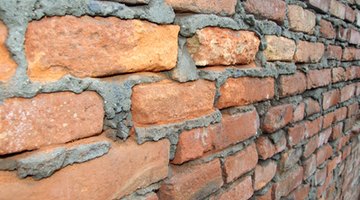How to Choose the Right Brick Mortar for 100 Year-Old Bricks
Many people consider mortar an afterthought, especially when it's supporting a historic brick wall. According to "Masonry Magazine," however, mortar actually makes up about 17 percent of a wall's surface area. Because it is such a significant part of a structure, it's critical to choose the right mortar for the job.

This is particularly true of old brick structures, where careful matching is required to ensure proper bonding and water-proofing.
-
Determine the age of your brick. According to "Old House Journal," brick produced before 1890 was made by hand, and was very soft. These bricks are irregular in shape and size, and are much more porous and subject to crumbling than newer bricks. After 1890, most bricks were mass produced, making them much harder and more regular. Take a sample to a local masonry supplier if you need help, or look closely at the condition and characteristics of the brick. If you know when your house was built, this can also help you determine the age of the brick.
-
Match the hardness of the mortar to the hardness of the brick. According to "Old House Journal," pre-1890 brick requires a soft mortar with a ratio of 3:1:0 of sand, lime and Portland cement, respectively. If the mortar is white, it requires a mix ratio of 10:3:1. For bricks made after 1890, use a harder mortar with a mix ratio of 9:2:1 of sand, lime and Portland cement.
-
Take a sample of the mortar to a masonry contractor for help with matching. Most mortar from the late 19th century through the mid-20th century is a mix of lime and Portland cement. Professionals can help you match the existing mortar, which will maximize your chance for successful refinishing or repair. Do not attempt to match the mortar if the bricks are spalling, crumbling or coated with a powdery white substance. These are all signs that the mortar is too hard for the brick, and that a softer mortar should be used.
-
Have a professional help you with color matching. Because of exposure to rain, wind and other exterior elements, mortar can change color over time, making it tough to match. Have a masonry supplier help you add color to your selected mortar mix to match the appearance of your existing walls.
-
Understand how mortar types are designated. According to the Portland Cement Association, mortar is designated as Type M, S, N or O. Type M contains the highest concentration of Portland cement, and is thus the strongest of the four. Type S contains slightly less cement, while Type N contains more lime than cement. Type O is primarily made of lime and contains little cement, making it the softest of the four.
-
Select mortar that will bond well with older brick. This will make installation easier while reducing the risk of leaks and cracking. According to "Masonry Systems," Types N and O are the most flexible and the best for bonding with old brick. Types M and S are much stiffer and won't bond as well with soft brick.
-
Choose Type N or Type S mortar when the brick is routinely exposed to freezing conditions. Type S in particular is designed to protect brick through extreme freeze/thaw cycles.
References
Writer Bio
Emily Beach works in the commercial construction industry in Maryland. She received her LEED accreditation from the U.S. Green Building Council in 2008 and is in the process of working towards an Architectural Hardware Consultant certification from the Door and Hardware Institute. She received a bachelor's degree in economics and management from Goucher College in Towson, Maryland.
Photo Credits
- old brick wall with half distroyed brick image by Cherry-Merry from Fotolia.com
- old brick wall with half distroyed brick image by Cherry-Merry from Fotolia.com
More Articles



